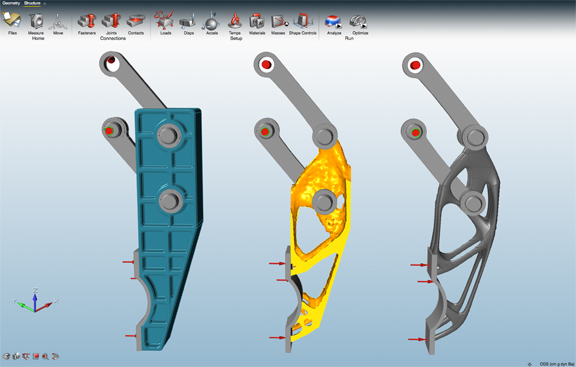
solidThinking INSPIRE, a topology optimization software for desktop users, will soon be available in a cloud-hosted version as INSPIRE Unlimited, announced Altair at its debut solidThinking CONVERGE event. (Image show solidThinking INSPIRE for desktop, courtesy of Altair.)
Latest News
September 16, 2016
 solidThinking INSPIRE, a topology optimization software for desktop users, will soon be available in a cloud-hosted version as INSPIRE Unlimited, announced Altair at its debut solidThinking CONVERGE event. (Image shows solidThinking INSPIRE for desktop, courtesy of Altair.)
solidThinking INSPIRE, a topology optimization software for desktop users, will soon be available in a cloud-hosted version as INSPIRE Unlimited, announced Altair at its debut solidThinking CONVERGE event. (Image shows solidThinking INSPIRE for desktop, courtesy of Altair.)In early September, under the warm southern California sun, the City of Angels played host to solidThinking CONVERGE Americas, the premiere event for engineering software maker Altair’s solidThinking brand. Arriving to kick off the conference, Altair’s Chairman and CEO James Scapa reflected, “We sort of evolved through the years. We’re not just a technical company anymore. Little by little, tripping and falling over ourselves, we’ve brought in a lot of designer-type people. We didn’t just bring them in; we’ve integrated them, so they change the way we work.” By his estimation, Altair now employs roughly “2,600 scientists, engineers, artists, and creative thinkers.”
Altair is best known for its HyperWorks software suite and OptiStruct solver, both widely used by advanced simulation software users. The solidThinking brand, which targets design engineers and simulation novices, encompasses EVOLVE, INSPIRE, Clock2Cast, and others. Altair products are traditionally associated with aerospace and automotive manufacturing projects. But the solidThinking brand’s reach, as suggested by the keynote talks at the debut conference in LA, is broader. The speaker lineup at the CONVERGE Americas conference include Janine Benyus, Cofounder of Biomimicry 3.8; Ralph Gilles, Head of Design for Fiat Chrysler Automobiles; and Jason Lopes, Lead Systems Engineer for Legacy Effects.
Biomimicry or Nature-inspired design usually involves complex shapes with biomechanical advantages; therefore, topology optimization is a good fit for the discipline. In projects with large assemblies, manufacturers often use topology optimization as a strategy to keep the weight and cost down. Emerging environmental concerns and fuel economy also favor lighter products.
Speaker Benyus pointed out that, by applying lighweighting strategies aggressively to products, structures, and buildings, humans can drastically reduce C02 emission, acting as if they themselves were the Glacier National Park that sequesters carbon output. “When we begin to act like the forest next door, that’s true biomimicry,” she suggested.
At the event, Altair revealed its plan to launch a new product, dubbed INSPIRE Unlimited. The existing product, INSPIRE, is a topology optimization software program for desktop installation and usage. The new offering, INSPIRE Unlimited (not yet available), will be cloud-hosted, delivered from the browser, powered by Microsoft Azure. It will also feature collaboration features to accommodate project teams working on the same design.
Scapa said, “When you’re able to run INSPIRE in the cloud, it gives you the power to do much larger batches of simulation to drive design.” James Daag, Altair’s CTO of Modeling and Visualization, said, “The impetus for us to put INSPIRE in the cloud is computer power. We’ll be releasing more products and applications that run on our cloud platform.”
Altair has already tested the cloud-hosted model with solidThinking ENVISION, a business intelligence and analytics program that runs in the cloud. The pending release of INSPIRE Unlimited is expected to benefit from the flexible computing power made possible by the cloud. Since topology optimization can be compute-intensive, the enabling software is a good candidate for the expandable cloud infrastructure.
Altair hasn’t publicly announced if it would also permit partner products and third-party apps to run on the same infrastructure as INSPIRE Unlimited. Another design software powerhouse, Autodesk, now offers its Autodesk Forge platform to developers interested in harnessing its technology components and platform. The news was made public in June. (For more, read “Autodesk Hosts First-Ever Forge Developer Conference” June 21, 2016.)
Since the appeal of the cloud is increasing, larger design software makers with cloud platforms for their own products may find themselves at a crossroad. They could keep their platform strictly for their own offerings. Or, they could open up the infrastructure to partners and affiliated developers, as a means to increase the variety and volume of applications available in their ecosystem. In doing the latter, they expand their role from being software makers to platform keepers and app custodians. It’s a role that some like Autodesk have embraced. Others may be reluctant to take on, due to revenue- and responsibility-sharing complexities.
With the debut CONVERGE event in LA out of the way, Altair now turns its attention to other CONVERGE conferences, set to occur in major cities in Germany, China, Japan, India, and Korea.
Subscribe to our FREE magazine, FREE email newsletters or both!
Latest News
About the Author
Kenneth Wong is Digital Engineering’s resident blogger and senior editor. Email him at [email protected] or share your thoughts on this article at digitaleng.news/facebook.
Follow DE





